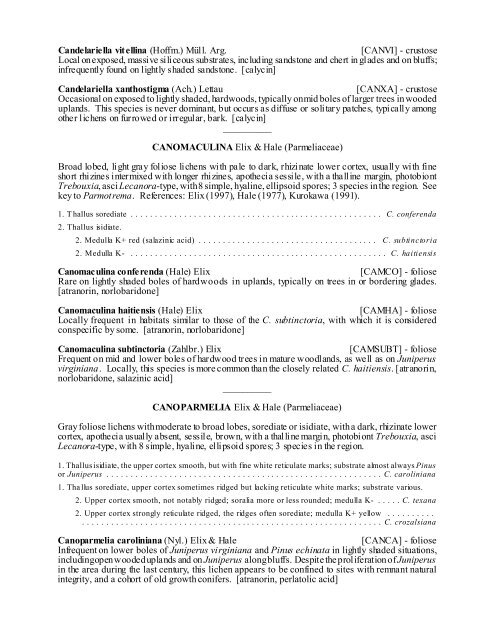lichens of the lower ozark region of missouri and arkansas
lichens of the lower ozark region of missouri and arkansas
lichens of the lower ozark region of missouri and arkansas
Create successful ePaper yourself
Turn your PDF publications into a flip-book with our unique Google optimized e-Paper software.
C<strong>and</strong>elariella vit ellina (H<strong>of</strong>fm.) Müll. Arg. [CANVI] - crustose<br />
Local on exposed, massive siliceous substrates, including s<strong>and</strong>stone <strong>and</strong> chert in glades <strong>and</strong> on bluffs;<br />
infrequently found on lightly shaded s<strong>and</strong>stone. [calycin]<br />
C<strong>and</strong>elariella xanthostigma (Ach.) Lettau [CANXA] - crustose<br />
Occasional on exposed to lightly shaded, hardwoods, typically on mid boles <strong>of</strong> larger trees in wooded<br />
upl<strong>and</strong>s. This species is never dominant, but occurs as diffuse or solitary patches, typically among<br />
o<strong>the</strong>r <strong>lichens</strong> on furrowed or irregular, bark. [calycin]<br />
__________<br />
CANOMACULINA Elix & Hale (Parmeliaceae)<br />
Broad lobed, light gray foliose <strong>lichens</strong> with pale to dark, rhizinate <strong>lower</strong> cortex, usually with fine<br />
short rhizines intermixed with longer rhizines, apo<strong>the</strong>cia sessile, with a thalline margin, photobiont<br />
Trebouxia, asci Lecanora-type, with 8 simple, hyaline, ellipsoid spores; 3 species in <strong>the</strong> <strong>region</strong>. See<br />
key to Parmotrema. References: Elix (1997), Hale (1977), Kurokawa (1991).<br />
1. T hallus sorediate .................................................... C. conferenda<br />
2. Thallus isidiate.<br />
2. Medulla K+ red (salazinic acid) ..................................... C. subtinctoria<br />
2. Medulla K- ..................................................... C. haitiensis<br />
Canomaculina conferenda (Hale) Elix [CAMCO] - foliose<br />
Rare on lightly shaded boles <strong>of</strong> hardwoods in upl<strong>and</strong>s, typically on trees in or bordering glades.<br />
[atranorin, norlobaridone]<br />
Canomaculina haitiensis (Hale) Elix [CAMHA] - foliose<br />
Locally frequent in habitats similar to those <strong>of</strong> <strong>the</strong> C. subtinctoria, with which it is considered<br />
conspecific by some. [atranorin, norlobaridone]<br />
Canomaculina subtinctoria (Zahlbr.) Elix [CAMSUBT] - foliose<br />
Frequent on mid <strong>and</strong> <strong>lower</strong> boles <strong>of</strong> hardwood trees in mature woodl<strong>and</strong>s, as well as on Juniperus<br />
virginiana. Locally, this species is more common than <strong>the</strong> closely related C. haitiensis. [atranorin,<br />
norlobaridone, salazinic acid]<br />
__________<br />
CANOPARMELIA Elix & Hale (Parmeliaceae)<br />
Gray foliose <strong>lichens</strong> with moderate to broad lobes, sorediate or isidiate, with a dark, rhizinate <strong>lower</strong><br />
cortex, apo<strong>the</strong>cia usually absent, sessile, brown, with a thal line margin, photobiont Trebouxia, asci<br />
Lecanora-type, with 8 simple, hyaline, ellipsoid spores; 3 species in <strong>the</strong> <strong>region</strong>.<br />
1. Thallus isidiate, <strong>the</strong> upper cortex smooth, but with fine white reticulate marks; substrate almost always Pinus<br />
or Juniperus .........................................................C. caroliniana<br />
1. Thallus sorediate, upper cortex sometimes ridged but lacking reticulate white marks; substrate various.<br />
2. Upper cortex smooth, not notably ridged; soralia more or less rounded; medulla K- .....C. texana<br />
2. Upper cortex strongly reticulate ridged, <strong>the</strong> ridges <strong>of</strong>ten sorediate; medulla K+ yellow ..........<br />
..............................................................C. crozalsiana<br />
Canoparmelia caroliniana (Nyl.) Elix & Hale [CANCA] - foliose<br />
Infrequent on <strong>lower</strong> boles <strong>of</strong> Juniperus virginiana <strong>and</strong> Pinus echinata in lightly shaded situations,<br />
including open wooded upl<strong>and</strong>s <strong>and</strong> on Juniperus along bluffs. Despite <strong>the</strong> proliferation <strong>of</strong> Juniperus<br />
in <strong>the</strong> area during <strong>the</strong> last century, this lichen appears to be confined to sites with remnant natural<br />
integrity, <strong>and</strong> a cohort <strong>of</strong> old growth conifers. [atranorin, perlatolic acid]


